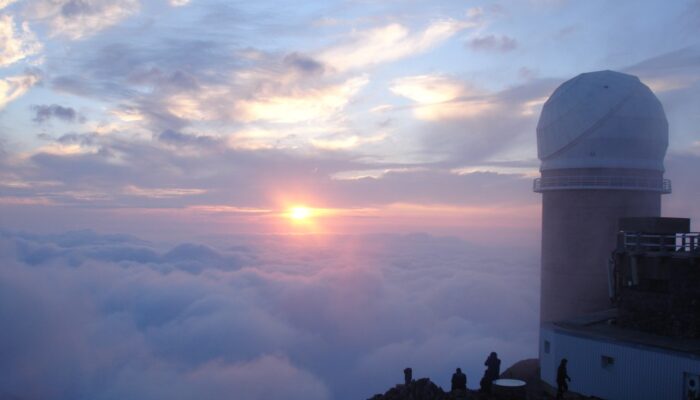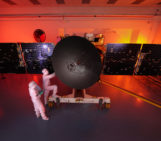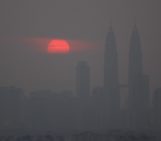
At sunset, the light travels a longer path in the atmosphere to reach our eyes than when the sun is high in the sky. At this time of the day, the light is more subject to scattering, as it interacts with more air (molecules and particles) before reaching our eyes, which explains why the sun is much less luminous and can be observed directly without being dazzled.
The sun appears redder because among the visible colours it emits, the blue radiation has been scattered by air molecules before this blue light reaches the observer. Indeed, the Rayleigh scattering theory says that the blue light (wavelength near 400 nm) is 16 times more scattered than the red light (wavelength near 800 nm). So the blue light is deviated outside the sun direction and only the remaining red light reaches the observer looking in the sun direction. This phenomenon also gives the blue colour of the sky when we look elsewhere than the direction of the sun.
Clouds consist of particles of liquid or solid water that are much larger than air molecules. It is then the Mie scattering theory that applies. This scattering favors no colour, which explains the milky colour of the clouds during the day. The clouds have the same colour of the solar radiation that strikes them. They therefore take a red colour at sunset and sunrise.
The night I took this photo, the beauty of the show was tinged with sadness: I came to the Pic du Midi Observatory in the Pyrenees (2800 m altitude) to observe the stars, not the clouds! This night of stars observation was a very great birthday present from my lab colleagues.
Luckily, the ceiling of the cloud layer lowered a little and the night was clear enough. The next morning, at dawn, the sea of clouds confined in the valleys also offered a grandiose spectacle.
By Claudine Vanbauce, Université de Lille, Laboratoire d’Optique Atmosphérique, France
If you pre-register for the 2019 General Assembly (Vienna, 07–12 April), you can take part in our annual photo competition! From 15 January until 15 February, every participant pre-registered for the General Assembly can submit up three original photos and one moving image related to the Earth, planetary, and space sciences in competition for free registration to next year’s General Assembly! These can include fantastic field photos, a stunning shot of your favourite thin section, what you’ve captured out on holiday or under the electron microscope – if it’s geoscientific, it fits the bill. Find out more about how to take part at http://imaggeo.egu.eu/photo-contest/information/.
Imaggeo is the EGU’s online open access geosciences image repository. All geoscientists (and others) can submit their photographs and videos to this repository and, since it is open access, these images can be used for free by scientists for their presentations or publications, by educators and the general public, and some images can even be used freely for commercial purposes. Photographers also retain full rights of use, as Imaggeo images are licensed and distributed by the EGU under a Creative Commons licence. Submit your photos at http://imaggeo.egu.eu/upload/.




